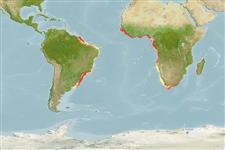>
Perciformes/Bembropoidei (Duckbill flatheads) >
Bembropidae (Duckbill flatheads)
Etymology: Bembrops: Greek, bembras, -ados = a kind of anchovy m+ Greek, ops = appearance (Ref. 45335); heterurus: Specific name probably from the Greek 'heteros' meaning different and 'oura' meaning tail..
Environment: milieu / climate zone / depth range / distribution range
Ecologie
marien demersaal; diepte 50 - 400 m (Ref. 6948), usually 80 - 200 m (Ref. 47377). Deep-water; 12°N -
Western Atlantic: off Rio de Janeiro, Brazil to Uruguay. Eastern Atlantic: Mauritania to the extreme northern waters of Namibia (Ref. 6948, 27121). The eastern Atlantic form referred to as Bembrops heterurus is unlikely to be conspecific with the Brazilian form, thus further taxonomic study is needed to clarify this situation (Ref. 6948).
Grootte / Gewicht / Leeftijd
Maturity: Lm ? range ? - ? cm
Max length : 28.0 cm TL mannelijk / geslacht onbekend; (Ref. 6948); common length : 20.0 cm TL mannelijk / geslacht onbekend; (Ref. 2683)
Dorsale stekels (totaal): 6; Dorsale zachte stralen (totaal): 14-15; Anale zachte stralen: 16 - 18. Color in alcohol light yellowish to yellowish brown dorsally, light yellowish brown to creamy brown ventrally. Upper lobe of caudal fin elongated at an acute angle. Snout relatively short, 1.0-1.4x eye diameter. Scales on lateral and dorsal surfaces of snout including area in front of eye. Upper jaw extending behind anterior margin of eye but not reaching its mid-line. Maxillary tentacle short. Lateral line descending gradually along dorsal edge of pectoral fin, separated from origin of first dorsal fin by 4 or 5 rows of scales, from origin of anal fin by 6 or 7, and from insertion of anal fin by 3-5. Pectoral fin moderately rounded. Lower lobe truncate or rounded (Ref 13203).
Found on soft bottoms of the continental shelf and feeds on crustaceans and fishes (Ref. 3656).
Levenscyclus en paargedrag
Maturiteit | Voortplanting | Paaien | Eieren | Fecunditeit | Larven
Das, M.K. and J.S. Nelson, 1996. Revision of the percophid genus Bembrops (Actinopterygii: Perciformes). Bull. Mar. Sci. 59(1):9-44. (Ref. 13203)
Status op de Rode Lijst van het IUCN (Ref. 130435)
Gevaar voor de mens
Harmless
Gebruik door de mens
Visserij: commercieel
Meer informatie
ReferentiesAquacultuurAquacultuurprofielKweeklijnenGeneticaElectrophoresesErfelijkheidZiektesVerwerkingNutrientsMassaconversie
Tools
Speciale rapporten
Download XML
Internetbronnen
Estimates based on models
Preferred temperature (Ref.
123201): 13.9 - 24.3, mean 16.8 °C (based on 91 cells).
Fylogenetische diversiteitsindex (Ref.
82804): PD
50 = 0.5000 [Uniqueness, from 0.5 = low to 2.0 = high].
Bayesian length-weight: a=0.00447 (0.00244 - 0.00818), b=3.08 (2.92 - 3.24), in cm total length, based on LWR estimates for this species & (Sub)family-body (Ref.
93245).
Trofisch niveau (Ref.
69278): 4.0 ±0.2 se; based on diet studies.
Fishing Vulnerability (Ref.
59153): Low vulnerability (18 of 100).
Nutrients (Ref.
124155): Calcium = 39.5 [22.6, 86.9] mg/100g; Iron = 0.449 [0.208, 0.883] mg/100g; Protein = 17.6 [16.5, 18.5] %; Omega3 = 0.278 [0.133, 0.571] g/100g; Selenium = 15.6 [6.0, 36.2] μg/100g; VitaminA = 13.8 [2.9, 63.8] μg/100g; Zinc = 0.446 [0.301, 0.661] mg/100g (wet weight);
